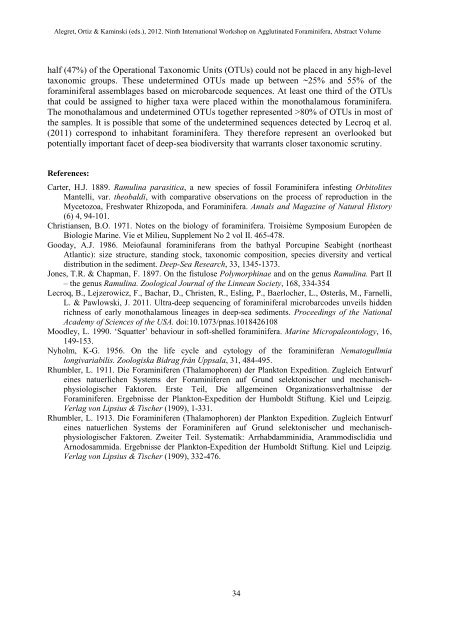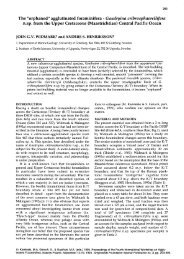Full Text | Download - Grzybowski Foundation - The ...
Full Text | Download - Grzybowski Foundation - The ...
Full Text | Download - Grzybowski Foundation - The ...
You also want an ePaper? Increase the reach of your titles
YUMPU automatically turns print PDFs into web optimized ePapers that Google loves.
Alegret, Ortiz & Kaminski (eds.), 2012. Ninth International Workshop on Agglutinated Foraminifera, Abstract Volume<br />
half (47%) of the Operational Taxonomic Units (OTUs) could not be placed in any high-level<br />
taxonomic groups. <strong>The</strong>se undetermined OTUs made up between ~25% and 55% of the<br />
foraminiferal assemblages based on microbarcode sequences. At least one third of the OTUs<br />
that could be assigned to higher taxa were placed within the monothalamous foraminifera.<br />
<strong>The</strong> monothalamous and undetermined OTUs together represented >80% of OTUs in most of<br />
the samples. It is possible that some of the undetermined sequences detected by Lecroq et al.<br />
(2011) correspond to inhabitant foraminifera. <strong>The</strong>y therefore represent an overlooked but<br />
potentially important facet of deep-sea biodiversity that warrants closer taxonomic scrutiny.<br />
References:<br />
Carter, H.J. 1889. Ramulina parasitica, a new species of fossil Foraminifera infesting Orbitolites<br />
Mantelli, var. theobaldi, with comparative observations on the process of reproduction in the<br />
Mycetozoa, Freshwater Rhizopoda, and Foraminifera. Annals and Magazine of Natural History<br />
(6) 4, 94-101.<br />
Christiansen, B.O. 1971. Notes on the biology of foraminifera. Troisième Symposium Européen de<br />
Biologie Marine. Vie et Milieu, Supplement No 2 vol II. 465-478.<br />
Gooday, A.J. 1986. Meiofaunal foraminiferans from the bathyal Porcupine Seabight (northeast<br />
Atlantic): size structure, standing stock, taxonomic composition, species diversity and vertical<br />
distribution in the sediment. Deep-Sea Research, 33, 1345-1373.<br />
Jones, T.R. & Chapman, F. 1897. On the fistulose Polymorphinae and on the genus Ramulina. Part II<br />
– the genus Ramulina. Zoological Journal of the Linnean Society, 168, 334-354<br />
Lecroq, B., Lejzerowicz, F., Bachar, D., Christen, R., Esling, P., Baerlocher, L., Østerås, M., Farnelli,<br />
L. & Pawlowski, J. 2011. Ultra-deep sequencing of foraminiferal microbarcodes unveils hidden<br />
richness of early monothalamous lineages in deep-sea sediments. Proceedings of the National<br />
Academy of Sciences of the USA. doi:10.1073/pnas.1018426108<br />
Moodley, L. 1990. ‘Squatter’ behaviour in soft-shelled foraminifera. Marine Micropaleontology, 16,<br />
149-153.<br />
Nyholm, K-G. 1956. On the life cycle and cytology of the foraminiferan Nematogullmia<br />
longivariabilis. Zoologiska Bidrag från Uppsala, 31, 484-495.<br />
Rhumbler, L. 1911. Die Foraminiferen (Thalamophoren) der Plankton Expedition. Zugleich Entwurf<br />
eines natuerlichen Systems der Foraminiferen auf Grund selektonischer und mechanischphysiologischer<br />
Faktoren. Erste Teil, Die allgemeinen Organizationsverhaltnisse der<br />
Foraminiferen. Ergebnisse der Plankton-Expedition der Humboldt Stiftung. Kiel und Leipzig.<br />
Verlag von Lipsius & Tischer (1909), 1-331.<br />
Rhumbler, L. 1913. Die Foraminiferen (Thalamophoren) der Plankton Expedition. Zugleich Entwurf<br />
eines natuerlichen Systems der Foraminiferen auf Grund selektonischer und mechanischphysiologischer<br />
Faktoren. Zweiter Teil. Systematik: Arrhabdamminidia, Arammodisclidia und<br />
Arnodosammida. Ergebnisse der Plankton-Expedition der Humboldt Stiftung. Kiel und Leipzig.<br />
Verlag von Lipsius & Tischer (1909), 332-476.<br />
34



